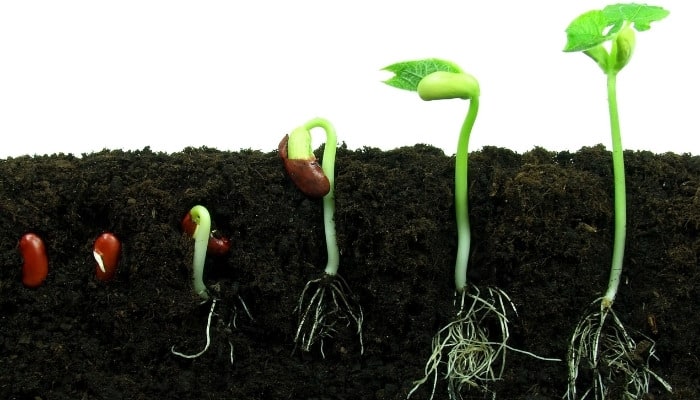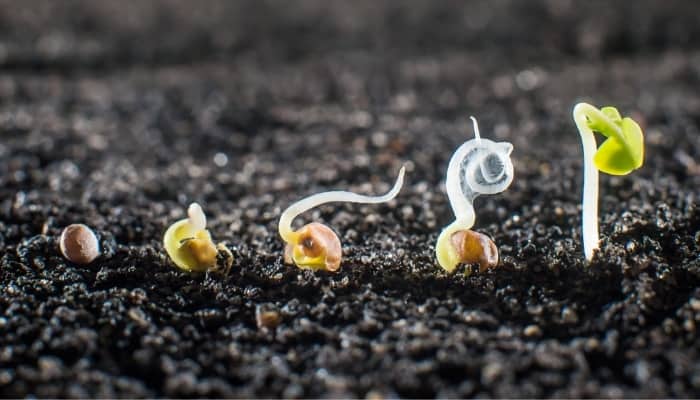The process of germination is when seeds develop into plants. Those new to gardening may choose to buy their plants already grown as seedlings from garden centers.
However, by purchasing seeds and germinating those seeds yourself, you can save money and grow more plants!
Many gardeners have learned a few tricks for how to get their seeds to germinate quicker, and we’ll share them below to jump-start your germination journey.
Germination Basics
The process of germination can be complicated when you break it down into each biological step. For our purposes, we are just focusing on germination as growing seeds into plants.
What Is Seed Germination?
Germination is the process of a seed leaving dormancy, sprouting, and growing into a plant. You may also hear the term “seed starting” in gardening.
Germination Process
The germination process will have differences among different species of plants. In general, the seeds need the right combination of factors to trigger germination.
Some of the factors include water, time, temperature changes, oxygen, and even light for some plants.
For most seeds, germination begins when a dry seed absorbs water and metabolic processes begin. The root will grow first to provide the new plant with water and nutrition.
The seed has a small number of stored resources to begin growth, but the root is necessary to continue the process.
Next, the seed will send up a stem with two leaves on it. As long as the right conditions continue to be met, the plant will continue to grow larger from this point.
What Are the Conditions Necessary for Germination?
The necessary conditions for germination vary from species to species. Some seeds require a long, cold dormancy. Others need high heat and humidity.
In general, most seeds need a moist environment, oxygen, and the proper temperature to germinate. Most seeds do not require light to germinate, but some, like lettuce and coleus, do need light.
Seed Germination Time
Once again, germination time varies between different species of plants. On average, seeds take 2-4 weeks to germinate.
Smaller seeds tend to absorb water quicker, allowing them to germinate sooner. Large, thick-shelled seeds need more time to absorb the water necessary to germinate.

How To Speed Up Germination
Most gardeners want their seeds to germinate as fast as possible. This allows a quicker turnaround time for the seed starting trays and allows the plants to begin growing sooner.
There are a few tricks that can help your seeds germinate faster. It may be a process of trial and error to find the tricks that work for you and the plants you are trying to grow.
Reference the seed packet and online resources for the best information on germinating a specific seed.
1. Nick the Seeds
Seeds have a strong, protective coat that prevents the vital interior from being damaged or compromised by pathogens.
Water has to penetrate this shell for germination to begin. Scarification, or the process of piercing the seed’s shell, can help speed up the germination process by allowing water to enter the seed.
Nicking the seeds should be done immediately before planting.
Larger seeds can be pierced using a small knife. Wear gloves, and be careful during the process. You just want to remove a small portion of the outer shell without damaging the interior of the seed.
For smaller seeds, line the inside of a jar with a piece of sandpaper. Add your seeds and shake the jar around.
The sandpaper will create minuscule scratches on the shells, making it easy for water to penetrate the seeds.
2. Soak the Seeds First
Since water begins the germination process, soaking the seeds can allow them to absorb the necessary water before they are even planted.
This is especially helpful for large seeds (like beans and squash) that have thicker shells.
Use hot water, and soak the seeds for around 24 hours. Too short of a soak will not be effective, and too long of a soak can lead to the seeds rotting.
3. Germinate on Damp Paper Towels
For this method, you’ll need an airtight container (preferably clear), a damp paper towel, and your seeds.
Dampen the paper towel so that it is saturated but there are no puddles. Place it inside the container. Spread the seeds on top of the paper towel, and close the lid.
If you’d like to soak the seeds before placing them in the paper towel, that’s fine and may speed things along even faster.
If you have multiple kinds of seeds in the same container, layer them and label each layer so you don’t get confused once they sprout.
Put your container in a warm location that does not receive direct sunlight. As soon as you see roots starting to emerge from the seeds, transplant them into the soil.
Do not let the roots get too long because it can be more difficult for the seedling to adjust after the transfer into the soil.
4. Place Seed Tray on a Heat Mat
The ideal temperature range for germination is 70-80 degrees Fahrenheit. If you do not have a place in your home to reach these temperatures, a heat mat can be helpful.
I like this one because of the waterproof, double-insulated pad and how easy it is to operate.
Just place your tray on the heat map, and wait for your seeds to germinate.
Keep in mind that covered trays will retain more heat. You want to make sure that you are not overheating the soil and the seeds. Many seeds cannot survive temperatures over 90℉.
5. Use Grow Lights for Extra Warmth
Another option to create the optimal germination temperature is to use grow lights. Most seeds don’t need light to germinate, but some bulbs give off heat to warm the seed tray.
This method can be helpful if you live in a cold environment or you are starting seeds during winter.
I recommend this full-spectrum light as it not only will help with germination but will also help the seedlings to grow strong once they emerge.
Once you’ve finished with seed germination, use the light on your indoor houseplants until you’re ready for it again next season.
6. Cover Seed Tray With a Humidity Dome
Since the seeds need moisture to trigger the germination process, a humidity dome can keep moisture in the air and soil.
Anything can be used as a cover to increase humidity, but clear covers are preferred so you can see the seeds and light will penetrate to aid the emerging seedlings.
Plastic take-out containers can make excellent seed trays and many come with clear lids. You can also use a plastic bag or plastic wrap to cover the top of your seed tray.
7. Plant Seeds in a Seed-Starting Mix – Not Potting Soil
Seed starting mix does not contain soil. It can be made from several different materials that hold moisture well. The lack of organic materials in the mixture can help prevent seedling disease.
Seed starting mix can be purchased from your local nursery or garden center. If you only have potting soil available, do not worry.
You can still germinate seeds in potting soil. Just be more mindful of monitoring the soil’s moisture levels. Excess moisture in organic material can harbor fungus and bacteria.
8. Germinate in an Instant Pot
This unique method for speeding up germination has been helpful for gardeners who live in extremely cold environments.
You’ll need an Instant Pot, damp paper towels, and a plastic bag. Place your seeds between damp paper towels inside the plastic bag. Place the bag inside the Instant Pot, and use the yogurt setting for constant low heat.
This process works great for hot-weather plants like peppers, tomatoes, and watermelons. You can modify the process for cold-weather plants.
Place the plastic bag on top of the Instant Pot while cooking. The warmth that radiates off the device will warm the seeds.
Conclusion
These tricks can not only improve the speed at which your seeds germinate, but they can also increase your germination success rate.
This means that for less money you can create more plants. Your garden will be overflowing in no time. Furthermore, you can enjoy the pride of successfully growing your plants from seeds.

